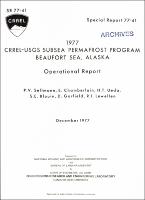Please use this identifier to cite or link to this item:
https://hdl.handle.net/11681/22931Full metadata record
| DC Field | Value | Language |
|---|---|---|
| dc.contributor.author | Sellmann, P. V. (Paul V.) | - |
| dc.contributor.author | Chamberlain, Edwin J. | - |
| dc.contributor.author | Ueda, Herbert T. | - |
| dc.contributor.author | Blouin, Scott | - |
| dc.contributor.author | Garfield, Donald E. | - |
| dc.contributor.author | Lewellen, Robert Irl | - |
| dc.date.accessioned | 2017-09-12T17:33:42Z | - |
| dc.date.available | 2017-09-12T17:33:42Z | - |
| dc.date.issued | 1977-12 | - |
| dc.identifier.uri | http://hdl.handle.net/11681/22931 | - |
| dc.description.abstract | During the spring of 1977 soil samples were obtained in the Prudhoe Bay area from one hole drilled on land and five holes drilled offshore. The study was a continuation of the program started the previous season to examine the engineering characteristics and properties of permafrost under the Beaufort Sea. Emphasis was placed on establishing the range of thermal and physical properties found in this geological setting, which is thought to be common to much of the eastern Alaska coastal zone. A probe study was also undertaken to increase our understanding of the engineering and thermal properties of this locality. Twenty-seven probe sites were selected to determine local engineering properties and temperature conditions, and to aid in interpreting the lithology between the drill holes. Core drilling information from some of the probe sites was used as control for interpreting the probe records. Deep thermal and geological information was obtained from the drill sites by the USGS personnel participating in the study. Maximum drill hole depth was 68.5 m (225 ft) and maximum penetration depth was 15 m (50 ft). The probe temperature data indicated the presence of permafrost in all holes. Probe penetration resistance measurements helped to delineate shallow, ice-bonded zones, some of which may have been only seasonal. In the core study, frozen sediments were found in only one hole, at approximately the 29.6-m (97-ft) depth. Sediment distribution ·patterns were much the same as those found in last year's observations, with fine-grained sediments common over the coarse-grained material, and a general increase in fine-grained sediment thickness with increasing distance from shore. The only departure from the previous year's field drilling techniques was the use of larger diameter, thick-walled casing and an air-operated casing driver. The probe equipment and techniques employed, however, represented a significant improvement over the prototype equipment used in 1976. | en_US |
| dc.description.sponsorship | United States. National Oceanic and Atmospheric Administration. | en_US |
| dc.description.sponsorship | United States. Bureau of Land Management. | - |
| dc.language.iso | en | en_US |
| dc.publisher | Cold Regions Research and Engineering Laboratory (U.S.) | en_US |
| dc.relation.ispartofseries | Special Report;77-41 | - |
| dc.subject | Continental shelf | en_US |
| dc.subject | Core drilling | en_US |
| dc.subject | Frozen ground | en_US |
| dc.subject | Biogeography | en_US |
| dc.subject | Ecology | en_US |
| dc.title | 1977 CRREL-USGS Subsea Permafrost Program, Beaufort Sea, Alaska : operational report | en_US |
| dc.type | Report | en_US |
| Appears in Collections: | Special Report | |
Files in This Item:
| File | Description | Size | Format | |
|---|---|---|---|---|
| Special Report 77-41.pdf | 1.68 MB | Adobe PDF |  View/Open |